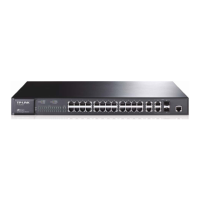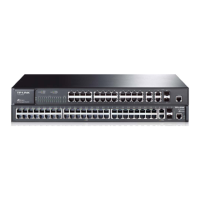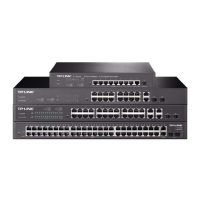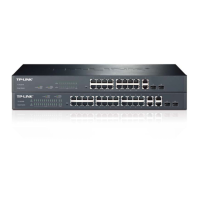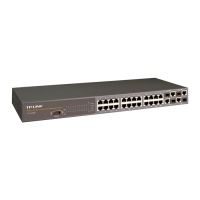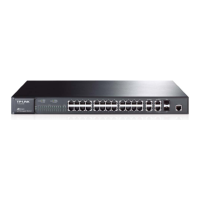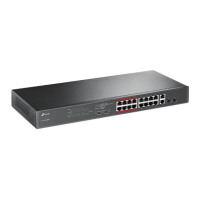Do you have a question about the TP-Link TL-SL3428 and is the answer not in the manual?
Identifies the target audience for this guide, focusing on network managers familiar with IT concepts.
Provides a summary of the guide's structure, outlining the content of each chapter.
Introduces the TL-SL3428/TL-SL3452 switch, its design, and key management features.
Highlights the primary features of the switch, including resiliency, layer 2 switching, QoS, and security.
Details the process of accessing the switch's configuration utility via a web browser.
Explains how to access the main setup menu after a successful login.
Covers configuration of system properties like summary, description, time, and IP settings.
Details managing user accounts, access levels, and login credentials for the web interface.
Provides functions for managing configuration files, firmware upgrades, and system reboots/resets.
Explains measures to enhance configuration management security via access control, SSL, and SSH.
Details configuring basic port features like status, speed, duplex, and flow control.
Explains Link Aggregation Group (LAG) for combining ports to increase bandwidth and reliability.
Provides tools to monitor traffic on each port, including traffic summary and statistics.
Covers viewing and configuring MAC address tables, including static, dynamic, and filtering entries.
Details the implementation of 802.1Q VLANs for network segmentation and traffic control.
Explains classifying VLANs based on network protocols for enhanced traffic management.
Describes the GARP VLAN Registration Protocol for dynamic VLAN information exchange.
Covers global STP settings, including enabling the function and configuring parameters.
Details security functions like Port Protect and TC Protect to prevent malicious attacks.
Explains IGMP Snooping for controlling multicast group membership and traffic flow.
Covers configuring multicast IP addresses and tables for efficient stream delivery.
Details setting up IP-range and port filters to control multicast group access.
Covers DiffServ settings like port priority, DSCP, 802.1P mapping, and schedule modes.
Allows controlling traffic rate per port using rate limiting and storm control features.
Details configuring Voice VLANs to prioritize voice data streams for improved quality.
Enables defining time ranges for ACL rules, including absolute, weekly, and holiday periods.
Covers creating and managing ACL rules such as MAC ACL, Standard-IP ACL, and Extend-IP ACL.
Explains binding ACL policies to specific ports or VLANs to enforce access control.
Details binding IP and MAC addresses to ports for network access control and security.
Covers ARP detection, defense, and statistics to mitigate ARP-related attacks.
Enables protection against Denial of Service attacks by configuring defense types.
Details 802.1X port-based authentication setup, including global and port configurations.
Covers global SNMP settings, views, groups, users, and community configurations.
Configures the switch to report important events to the management station via traps or informs.
Details Remote Monitoring capabilities for network statistics, events, and alarms.
Covers global and port-specific LLDP parameters for network device discovery.
Allows viewing local and neighbor device information gathered via LLDP.
Provides statistics on LLDP traffic, including sent, received, and discarded packets.
Details Neighbor Discovery Protocol settings for discovering network devices.
Covers Neighbor Topology Discovery Protocol for collecting network topology information.
Explains configuring cluster roles, status, and managing member switches via the commander.
Monitors CPU and memory utilization, providing graphs for performance analysis.
Includes Cable Test and Loopback functions for diagnosing network connectivity issues.
Provides Ping and Tracert tests to check network connectivity and troubleshoot issues.
Guides through the initial hardware setup for firmware maintenance via FTP.
Details configuring Hyper Terminal on a PC for managing the switch's console port.
Explains the process of downloading firmware to the switch using the bootUtil menu.
Identifies the target audience for this guide, focusing on network managers familiar with IT concepts.
Provides a summary of the guide's structure, outlining the content of each chapter.
Introduces the TL-SL3428/TL-SL3452 switch, its design, and key management features.
Highlights the primary features of the switch, including resiliency, layer 2 switching, QoS, and security.
Details the process of accessing the switch's configuration utility via a web browser.
Explains how to access the main setup menu after a successful login.
Covers configuration of system properties like summary, description, time, and IP settings.
Details managing user accounts, access levels, and login credentials for the web interface.
Provides functions for managing configuration files, firmware upgrades, and system reboots/resets.
Explains measures to enhance configuration management security via access control, SSL, and SSH.
Details configuring basic port features like status, speed, duplex, and flow control.
Explains Link Aggregation Group (LAG) for combining ports to increase bandwidth and reliability.
Provides tools to monitor traffic on each port, including traffic summary and statistics.
Covers viewing and configuring MAC address tables, including static, dynamic, and filtering entries.
Details the implementation of 802.1Q VLANs for network segmentation and traffic control.
Explains classifying VLANs based on network protocols for enhanced traffic management.
Describes the GARP VLAN Registration Protocol for dynamic VLAN information exchange.
Covers global STP settings, including enabling the function and configuring parameters.
Details security functions like Port Protect and TC Protect to prevent malicious attacks.
Explains IGMP Snooping for controlling multicast group membership and traffic flow.
Covers configuring multicast IP addresses and tables for efficient stream delivery.
Details setting up IP-range and port filters to control multicast group access.
Covers DiffServ settings like port priority, DSCP, 802.1P mapping, and schedule modes.
Allows controlling traffic rate per port using rate limiting and storm control features.
Details configuring Voice VLANs to prioritize voice data streams for improved quality.
Enables defining time ranges for ACL rules, including absolute, weekly, and holiday periods.
Covers creating and managing ACL rules such as MAC ACL, Standard-IP ACL, and Extend-IP ACL.
Explains binding ACL policies to specific ports or VLANs to enforce access control.
Details binding IP and MAC addresses to ports for network access control and security.
Covers ARP detection, defense, and statistics to mitigate ARP-related attacks.
Enables protection against Denial of Service attacks by configuring defense types.
Details 802.1X port-based authentication setup, including global and port configurations.
Covers global SNMP settings, views, groups, users, and community configurations.
Configures the switch to report important events to the management station via traps or informs.
Details Remote Monitoring capabilities for network statistics, events, and alarms.
Covers global and port-specific LLDP parameters for network device discovery.
Allows viewing local and neighbor device information gathered via LLDP.
Provides statistics on LLDP traffic, including sent, received, and discarded packets.
Details Neighbor Discovery Protocol settings for discovering network devices.
Covers Neighbor Topology Discovery Protocol for collecting network topology information.
Explains configuring cluster roles, status, and managing member switches via the commander.
Monitors CPU and memory utilization, providing graphs for performance analysis.
Includes Cable Test and Loopback functions for diagnosing network connectivity issues.
Provides Ping and Tracert tests to check network connectivity and troubleshoot issues.
Guides through the initial hardware setup for firmware maintenance via FTP.
Details configuring Hyper Terminal on a PC for managing the switch's console port.
Explains the process of downloading firmware to the switch using the bootUtil menu.
| MAC Address Table | 8K |
|---|---|
| Fan Quantity | 2 |
| Packet Buffer Memory | 4 MB |
| Storage Temperature | -40°C to 70°C |
| Standards and Protocols | IEEE 802.3, IEEE 802.3u, IEEE 802.3x, IEEE 802.1q, IEEE 802.1p |
| Power Supply | 100~240VAC, 50/60Hz |
| Dimensions (W x D x H) | 440 x 220 x 44 mm |
| Operating Temperature | 0°C to 40°C |
| Operating Humidity | 10% to 90% non-condensing |
| Storage Humidity | 5% to 90% (non-condensing) |
| Jumbo Frame | 9KB |
| Weight | 2.15 kg |
